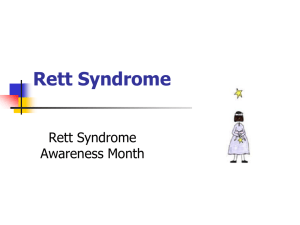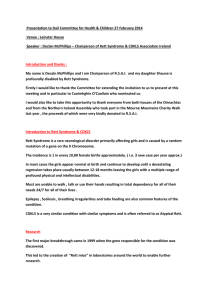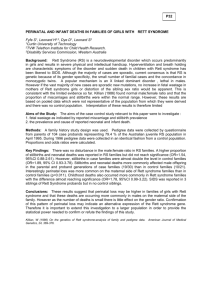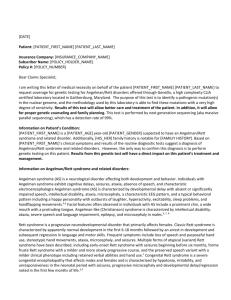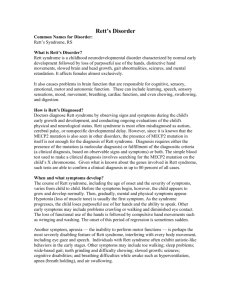Rett syndrome
advertisement
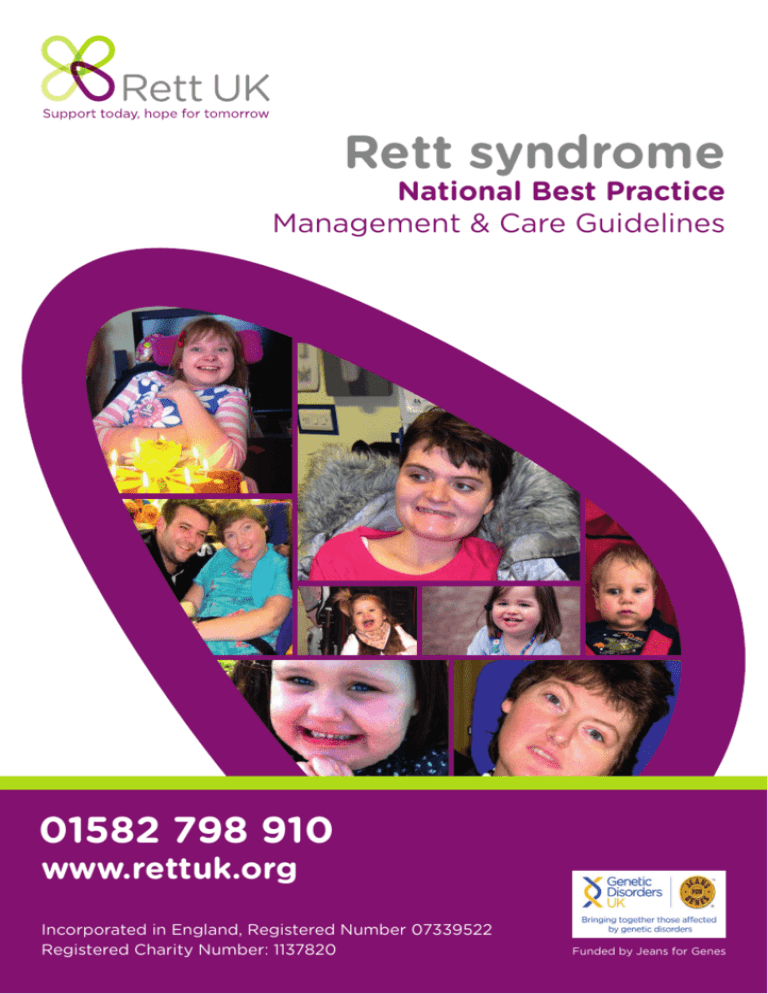
Rett syndrome National Best Practice Management & Care Guidelines 01582 798 910 www.rettuk.org Incorporated in England, Registered Number 07339522 Registered Charity Number: 1137820 Funded by Jeans for Genes Winter 2013 Contents 2 Foreword 3 Introduction 5 Information for Professionals 7 Genetic Investigation 8 Prenatal Testing 10 Clinical Considerations: A to Z 12 Therapeutic Interventions 17 Clinical Health Transition 18 About Rett UK 19 Rett syndrome Syndrome National National Best Best Practice: Practice :Guidelines Guidelines Foreword Professor Angus Clarke, Cardiff University I have been asked to contribute a foreword to this document, the first National Best Practice Guidelines for Rett syndrome in the UK. Although the document is short, it is a big step. This is the result of Rett UK’s sustained work with families and professionals over many years, from when it was founded as the Rett syndrome Association UK and ever since. This has allowed professionals, families and support workers to accumulate experience as to how patients with Rett syndrome can best be supported. There is still much more to do - we need to develop and disseminate expertise in handling multiple aspects of the care of those affected by Rett syndrome - but this is an excellent start. If we compare this to the National Best Practice Guidelines for Rett syndrome that will be current in another ten years, in 2023, what changes will we see? I think (and hope!) that there will be four major differences, which it can be our Ten Year Plan to develop. (i) I think that we will then be able to map out an approximate temporal sequence of the questions likely to arise and the inputs likely to be needed at different ages. (ii) I expect that we will have much more detail to include in the pathway about the physiological monitoring of the affected girls, as it will be relevant to treatment. (iii) I expect that eye gaze technology will be in regular use in homes and schools to promote communication with those affected. I think that this will reveal much more variation in the cognitive abilities of patients with Rett syndrome than we have appreciated until now. I think that some girls may even have levels of cognitive functioning within the normal range (IQ>70), although many others will not. March 2013 3 And finally, (iv) I expect that there will be a substantial focus on medical treatments, including both conventional medications to help suppress seizures and to control digestion, breathing and heart rate, and at least some rational, gene-based treatments designed to evade the damaging effects of MeCP2 deficiency. However, I have no idea as to which of the current approaches being developed will prove to be both safe and effective. As must now be evident, I am an optimistic tortoise. I think that progress is happening and will continue, but that we have to be prepared for a slow and steady campaign rather than taking the hare’s inspired lightning dash for granted. If there is a cure around the corner then we can all rejoice, but we had better prepare for the long haul because that seems more likely. It is important to steer a skilful path between the Scylla of false hopes and the Charybdis of despair. We must not amplify or exploit the alternation between hope and hopelessness that affects many in the families of those affected by Rett syndrome and other, similarly devastating, conditions. We must be realistic and acknowledge that the development of treatments takes time, patience and commitment from researchers, clinicians and families together. Professor Angus Clarke Cardiff University 4 Rett syndrome Syndrome National National Best Best Practice: Practice :Guidelines Guidelines Introduction What is Rett syndrome? Rett syndrome is a complex neurological disorder that is usually diagnosed in early childhood and which predominately affects females. Rett syndrome is caused by a genetic mutation which is usually brought to the child in either the sperm or the egg and is therefore present at the time of conception. The name of the gene in which alterations (mutations) occur is MECP2 (methyl CpG binding protein 2). It is found on the long arm of the X chromosome. When written MECP2 this stands for the gene itself. When written as MeCP2 it is referring to the protein made by the gene. How can Rett syndrome be recognised? The age when Rett syndrome symptoms begin and the severity of different symptoms will vary. The child is usually born healthy and shows an early period of normal or near normal development until six to eighteen months of life, when there is a slowing down or stagnation of skills. A period of regression then follows, when communication skills and purposeful hand movements are lost. Stereotyped hand movements, gait disturbances and slowing of the normal rate of head growth become apparent. Other problems may include seizures, irregular breathing patterns, inconsolable crying, screaming and general irritability. How do you diagnose Rett syndrome? Depending on how early the problem presents, the child who has Rett syndrome may require many investigations because there are many other disorders which may cause the failure to develop or the loss of skills. Rett syndrome is diagnosed by looking for signs and behaviours leading to a clinical diagnosis and is then confirmed in most cases by carrying out a genetic test. The Guidelines These Guidelines will facilitate the development of local integrated National Best Practice Guidelines for people with Rett syndrome and provide a means to link them and their families with community services, hospitalbased services, social care, education and voluntary organisations in one joined-up process. March 2013 5 The provision of these Guidelines can only serve to benefit the estimated 2,500 people in the UK with this disorder. From diagnosis the Guidelines will describe the journey through RTT*, mapping symptoms, identify treatments and coping strategies to minimise concerns and promote better quality services. Without a diagnosis, families are unable to identify the correct health services. Without understanding the progression of Rett syndrome, individuals may suffer avoidable symptoms. Without signposting and information, people may not receive their full entitlements and appropriate support. Rett UK is seeking to address these problems through the provision of information regarding timely and appropriate intervention. The Guidelines are in a clear format that is easily accessible to anybody involved in the care of an individual living with Rett syndrome. The Audience The document is designed to provide different levels of information to assist professionals in identifying the symptoms and diagnosing Rett syndrome. The best practice guidelines are part of a larger portfolio of information and are accompanied by additional volumes for families and will include an educational supplement. Copies of other information documents are available on request from Rett UK. As Rett syndrome is a rare neurological disorder, it will be unlikely that many healthcare professionals usually responsible for managing and coordinating the care of people with the condition will have had much prior experience of the syndrome. People with Rett syndrome may require various diagnostic and screening tests, assessments, referrals and multi-disciplinary interventions at different stages of their lives. So although this has been prepared for professionals, it will also be of interest to parents/carers of individuals living with Rett syndrome. If you are reading these Guidelines as a parent/carer, please do bear in mind that your child may not be affected by all the symptoms mentioned. We recognise that every individual living with Rett syndrome is unique and symptoms vary from person to person. If you have any concerns about the information or would like a copy of our Family Companion, which contains information sheets covering a wide range of topics then please contact Rett UK on 01582 798911. 6 Rett syndrome Syndrome National National Best Best Practice: Practice :Guidelines Guidelines Information for Professionals * RTT is the official OMIM symbol for Rett syndrome Clinical Diagnosis (Rett Diagnostic Criteria 2010, J L Neul et al) Consider diagnosis when postnatal deceleration of head growth is observed. Required for typical or classic RTT: Period of regression followed by recovery or stabilisation All main criteria and all exclusion criteria Supportive criteria are not required, although often present in typical RTT Required for atypical or variant RTT: Period of regression followed by recovery or stabilisation At least 2 of the 4 main criteria 5 out of 11 supportive criteria Main Criteria 1. 2. 3. 4. Partial or complete loss of acquired purposeful hand skills. Partial or complete loss of acquired spoken language. Gait abnormalities; impaired (dyspraxic) or absence of ability. Stereotypic hand movements such as hand wringing/squeezing, clapping/tapping, mouthing and washing/rubbing automatisms. Exclusion Criteria for Typical RTT 1. Brain injury secondary to trauma (peri- or postnatally) neurometabolic disease or severe infection that causes neurological problems. 2. Grossly abnormal psychomotor development in first 6 months of life. Supportive Criteria for Atypical RTT 1. Breathing disturbances when awake 2. Bruxism when awake 3. Impaired sleep pattern 4. Abnormal muscle tone 5. Peripheral vasomotor disturbances 6. Scoliosis/kyphosis 7. Growth retardation 8. Small, cold hands and feet 9. Inappropriate laughing/screaming spells 10. Diminished response to pain 11. Intense eye communication – “eye pointing” March 2013 7 Genetic Investigation The diagnosis of RTT should be based on the clinical presentation, according to the criteria overleaf. This diagnosis will be considered when a child (especially a girl) is thought to show regression in her development, as RTT is the commonest single genetic cause of regression in girls during infancy. The condition may also be suspected earlier - before regression has occurred - if a child shows developmental stagnation and some of the behavioural features of RTT, such as hand stereotypies, passivity and social withdrawal. A molecular genetic test to confirm the diagnosis - a search for mutations in the MECP2 gene - is useful for several reasons: If a mutation is found in MECP2, then it confirms the diagnosis and further investigations into the aetiology are not required unless additional or atypical clinical features emerge. The family can be given a realistic prognosis for their child with some confidence, although of course prediction of the precise course of the condition in an individual is not possible even when the mutation is well known. The best guide to a child’s future development is usually an extrapolation from their development up to that point, but this assessment is more difficult in the case of a child with RTT. 8 Rett syndrome Syndrome National National Best Best Practice: Practice :Guidelines Guidelines It also becomes possible to offer prenatal diagnosis in the event of a future pregnancy, and the risks of recurrence (for the couple or other family members) can be clarified by referral to a clinical geneticist. If the parents wish, they can be tested to see if they carry the MECP2 mutation. While the chance of this is small, it makes a very substantial difference to the chance of another child being affected. It may therefore be appropriate if the parents request it or if they wish to consider another pregnancy. If a mutation is not found in MECP2, as occurs in 5-10% of those with classic features of RTT, then the clinical diagnosis remains. It is important not to remove the clinical diagnosis simply because it has not been confirmed by laboratory testing: it has not been invalidated. When this situation arises, however, it may be helpful for an experienced clinician to reassess the child to look for further clinical signs of RTT or for evidence of other possible diagnoses, such as CDKL5 or FOXG1 mutations. Delivering the News Families should, wherever possible, be given the diagnosis in a discussion face to face and preferably with both parents present, so that they are able to ask questions. They should also be provided with some basic information about the syndrome and signposted to organisations that will be able to help provide further information and support. Referral to Appropriate Specialists The family should be offered genetic counselling, particularly if the diagnosis of Rett syndrome is in their first child. They should also be supported to obtain appointments with a paediatric neurologist and with a consultant community paediatrician who will coordinate the local therapy team, which will provide advice to help the family support the child. The therapists who may be involved are likely to come from physiotherapy, speech & language therapy, occupational therapy and music therapy. March 2013 9 Prenatal Testing In the vast majority of cases, Rett syndrome is caused by a new, sporadic mutation in the sperm (more often) or the egg; the risk of recurrence is then very small. For the parents of a child with RTT, however, deciding whether to extend their family is an important decision and parents deserve all the information and support they can be given. If the affected child’s mutation is known, then it is possible to test any subsequent pregnancy. If the parents request prenatal diagnosis, this can be performed by either Chorionic Villus Sampling (CVS) or by amniocentesis. Both techniques carry a small chance of causing a miscarriage. Prenatal diagnosis will usually be carried out with the intention of terminating a pregnancy in which the foetus carries the family’s MECP2 mutation. The decision about whether to seek prenatal diagnosis, and what to do if the next child would be affected, are clearly very personal matters and each family should be supported in whatever decision they make. Referral for genetic counselling is recommended early in a pregnancy when the family may have questions or wish to consider testing. With the mutation known, it is also possible to test the parents in advance of a pregnancy to refine the information given about the risk of recurrence. On rare occasions the mother will be shown to carry, on one of her two X chromosomes, the same MECP2 mutation as that found in her daughter. The risk of another child being affected is then approximately 50% (a 50% chance of a boy suffering from a severe encephalopathy in infancy; a nearly 50% chance of a daughter developing RTT). The mother will have escaped the ill effects of the mutation through the good fortune of inactivating the X chromosome carrying the mutation in most or all of her cells. 10 Rett syndrome Syndrome National National Best Best Practice: Practice :Guidelines Guidelines Very rarely, either the mother or the father may be shown to carry the MECP2 mutation in some but not all of their cells. The individual is then said to be mosaic for the mutation - to show somatic mosaicism - as they consist of two types of cells, those with the mutation on their X chromosome (if male) or on one of their two X chromosomes (if female), and those in whom the mutation cannot be found (i.e. normal). The risk of a child being affected will be up to 50%, but often somewhat less, if the mutation is found at all in either parent. If there is no sign of the mutation in the blood samples from either of the parents, then the risk of another child being affected is of the order of 1% and probably less. A recurrence would only happen if one parent was mosaic for the mutation but with the mosaicism confined to the germline, so that a number of sperm may carry the same mutation but not the blood cells. The same may occur with the mother’s oocytes, but probably less frequently. Whilst the risk of recurrence of Rett syndrome may be low, the risk and impact on the family of having a second child with another genetic disorder (e.g. Down’s syndrome) also needs to be considered when deciding whether to have prenatal testing. If the parents are anxious in case their next child might be affected with Rett syndrome or another condition, then the family should be given the option of discussing this with the genetics team. Being provided with all the help and support they need, will enable them to decide whether to embark upon or continue with a pregnancy. March 2013 11 Clinical Considerations: A to Z Abdominal Distension This can be due to aerophagy, which commonly accompanies the abnormal breathing; very severe cases may be helped by percutaneous gastrostomy. Some cases may also be helped by medication. Aerophagia Air swallowing can be significant and can interfere with eating and full respiratory effort. Apraxia Apraxia results from dysfunction of the cerebral hemispheres of the brain, especially the parietal lobe, and can be present in people with Rett syndrome. Apraxia includes limb-kinetic apraxia (the inability to make fine, precise movements with an arm or leg), ideomotor apraxia (the inability to make the proper movement in response to a verbal command), ideational apraxia (the inability to coordinate activities with multiple, sequential movements, such as dressing, eating, and bathing), verbal apraxia (difficulty coordinating mouth and speech movements), constructional apraxia (the inability to copy, draw, or construct simple figures), and oculomotor apraxia (difficulty moving the eyes on command). Apraxia may be accompanied by a language disorder called aphasia. Generally, treatment for individuals with apraxia includes physical, speech, or occupational therapy. Aspiration Pneumonia Food is passed into the lungs. This is due to poor co-ordination of the muscles that move the food from the back of the tongue to the pharynx and down the oesophagus. The epiglottis should fold over the trachea, to prevent the food or fluid from being inhaled, but fails to do so. Careful assessment of swallowing by an experienced speech therapist is required. Positioning is key to enhance swallowing, as is the texture of the food and consistency of the fluid. Breathing Irregularities Breathing rhythm is unstable, usually normal while asleep and abnormal on waking. Apneustic breathing often predominates in the young. Shallow breathing, breath holding and central apnoeas may lead to severe hypoxia. These are entirely outside of the control of the individual. 12 Rett syndrome Syndrome National National Best Best Practice: Practice :Guidelines Guidelines Bone Density Osteoporosis is common in Rett syndrome and should be monitored by an endocrinologist as the child grows. This condition should be considered particularly in those who have never walked or who regularly have fractures. Bone density is also affected by anti-convulsants. A DEXA bone density scan should be undertaken in the event of a fracture, or simply to provide a baseline. A reduced bone density may trigger assessment of calcium and vitamin D intake or may prompt specific treatments to enhance bone mineral content. Bruxism Tooth grinding can be severe but does not occur during sleep. Involving a specialist dentist is important to prevent tooth decay and enamel problems. Constipation Treat vigorously and actively with an eye towards prevention. Bowel habits can change over time and can be a source of pain and discomfort. Even if dietary fibre is adequate, check the daily free water intake, which may be low. Drooling Excessive saliva and drooling are common, especially in those who have difficulty in closing their mouths. Medication can be used to control this and some may benefit from surgical procedures, including salivary duct adjustment or re-routing, parasympathetic nerve surgery and salivary gland removal. Dystonia Dystonic spasms are common. Gentle massage may be more effective than medication. Epileptic Seizures The majority of girls with RTT will have clinical seizures at some stage. An initial EEG is generally done during the regression phase and may be abnormal, with or without clinical seizures. Seizures can be of several different types, including major motor, complex partial, atonic, or myoclonic and may be relatively simple to control or highly complex. Puberty can bring about changes in seizure pattern and activity. March 2013 13 The main risk is over-diagnosis. Although epilepsy is common, affecting up to 65% of people with Rett, there are many episodes that can mimic seizures, including breath-holding spells, vacant episodes, dystonic posturing and painful gastro-oesophageal reflux. The situation can be more difficult to manage in people who have definite epilepsy alongside a variety of other episodes. Video-EEG monitoring and/or a specialist opinion should be sought before resorting to high dose polypharmacy. Feeding Difficulties This can be common in RTT, and may worsen with increasing muscle tone. Poor weight gain and episodes of aspiration require fluoroscopic examination and pH studies. In severe cases percutaneous gastrostomy (PEG) should be considered. Persistent reflux may need surgical correction. Gastrointestinal Constipation, diarrhoea, intestinal gas and gastric reflux are all common problems. It is possible to be severely constipated and, as a result, have diarrhoea intermittently. When a mass of stools accumulates in the rectum, faecal material from high in the colon can trickle around the obstruction (‘overflow faecal incontinence’). Hand Stereotypies Hand stereotypy is involuntary and increased by alerting. It can be ignored unless injury occurs, when a light elbow splint may be used to prevent injury with minimal interference. Task performance may improve with one hand gently held (only during the task). Impaired Sleep This includes night terrors, inappropriate laughing and jerking. Once awake, people can take a long time to fall asleep again due to irregular breathing patterns, seizure activity and general restlessness. Involuntary Behaviours Periodic unexplained agitation, laughing or crying is common and may be associated with poor central parasympathetic restraint. Agitation is also the means to express any pain, irritation, discomfort, distress, anger, frustration or boredom and such causes must be carefully excluded. Sedatives and antipsychotics should be avoided. Short term use of a serotonin reuptake inhibitor may be helpful in extreme cases. 14 Rett syndrome Syndrome National National Best Best Practice: Practice :Guidelines Guidelines Long QT Syndrome Prolonged QT intervals have been reported in girls with RTT and may be life threatening. Baseline ECG should be obtained and then repeated at intervals: the appropriate interval is not known but every three years has been suggested. However, careful consideration would be required before making a decision to treat a cardiac dysrhythmia with implantable defibrillator because of the distress that may be caused by the implantation procedure itself and by cardioversion events in those unable to understand what is happening to them. Mobility There is a wide range of ability; some affected patients will never walk, whilst others walk for decades. Some have almost no hand skills while others perform some purposeful actions. Other issues include balance issues, spatial disorientation, ataxia, tremors, hypotonia, hypertonia, rigidity, dystonia and difficulty with transitional movements. Non-Epileptic Vacant Spells These can be more frequent than epileptic seizures in RTT and are due to impaired brain stem cardiorespiratory control. This may lead to episodes of loss of consciousness, which may be difficult to distinguish from epilepsy and may require concurrent monitoring of central autonomic function with EEG. Vagal tone and baroreflex sensitivity are usually reduced. Osteoporosis Osteoporosis has been reported in RTT, even in active people. A balance must be found between providing active movement, which is essential for health and adequate protection from trauma. Oral Motor Function Dysphagia is common in RTT. People may have, or develop difficulty with, chewing, tongue movement and swallowing. This may impair adequate nutrition or contribute to respiratory symptoms (aspiration, coughing, or choking during feeding). Range of Motion Contractures develop over time. Check for full passive range of motion. Reduction in Occupational and Physiotherapy services over time can lead to lack of awareness of this complication. March 2013 15 Sleep Disorders These may include failure to go to sleep, night time waking and day time sleeping. Melatonin may help to establish a routine. The Spine: Scoliosis/ Kyphosis/Lordosis The chance of developing scoliosis increases with age. Approximately one quarter of girls develop scoliosis by 6 years of age and three quarters by 13 years of age. Those who have never walked have been shown to be twice as likely to develop scoliosis as girls who have learned to walk. There should be close monitoring of the spine with baseline X-rays taken in early childhood. Proactive involvement of an orthopaedic surgeon is important, as is early intervention and management. Vasomotor Disturbances Sympathetic tone is high, due to poor autonomic restraint. Treat the skin gently, encourage activities using the whole body, and ensure that hands and feet are kept warm even in the summer. Weight Poor weight gain is a common complication and can occur at any age. As one easily obtainable measure of nutritional status, weight should be measured regularly and recorded. 16 Rett syndrome Syndrome National National Best Best Practice: Practice :Guidelines Guidelines Therapeutic Interventions Hydrotherapy Hydrotherapy is one of the most essential of the physical therapies for this group of profoundly disabled people. There are several reasons for the importance of this form of therapy, each of which relates to the nature of the disorder: RTT produces a movement disorder which deprives the individual of the freedom to plan and carry out voluntary movement. This means that walking is never secure and sometimes impossible. The difficulties which lead to the movement problem include fear, which seems to be induced by perceptual difficulties. Although RTT is not a progressive disease there is a liability to lose muscle bulk, strength and flexibility because the brain is not capable of using the existing nerve pathways in a normal fashion and this leads to poor internal nutrition of the tissues. Music Therapy Music therapy has enormous value in aiding communication skills, improving gross and fine motor skills, helping with attention and general motivation and emotional well-being. It can also reduce stereotypies and functional use of hands can be developed. Music can also be used to relax and calm. Occupational Therapy We strongly recommend that the individual’s overall 24 hour postural management should be considered carefully and reassessed at regular intervals. Individuals should be fully assessed for each piece of equipment that will promote functional hand use, and sensory input encouraged to improve overall quality of life. March 2013 17 Physiotherapy This is important in ensuring good postural management to influence scoliosis and joint deformities, develop or maintain transitional skills, increase motor ability, stimulate hand use, improve body awareness, reduce muscle pain and increase protective responses. Speech and Language Therapy Supporting communication skills for people with RTT is vital to improve concentration and develop effective communication methods. Speech and language therapists also have a responsibility to identify eating difficulties and provide advice about the texture of food and drink, adapted utensils and altering the pace of eating, as dysphagia and aspiration pneumonia are common problems. The role of interactive eye gaze technology in facilitating communication for people with RTT is uncertain but looks promising for many affected individuals. This may also prove useful in the assessment of cognitive function. Clinical Health Transition People with Rett syndrome will be receiving a variety of services from the NHS, from social services and education authorities. Once the overall coordination of care transfers from the paediatrician into adult care, there is no one single person responsible for co-ordinating this care except the GP. Therefore early preparation for this is important. Planning how to meet the complex health and social care needs for adults with Rett syndrome can be challenging. Annual Health checks are vital, with particular emphasis on early detection and treatment of conditions such as scoliosis, osteoporosis, and epilepsy. Acknowledgements Professor Angus Clarke, Consultant, Clinical Genetics, Cardiff University School of Medicine: Cardiff Clinic Dr Jane Williams, Consultant Paediatrician, Nottingham City Hospital: Nottingham Clinic Professor Hilary Cass, Consultant in Paediatric Neurodisability, St Guys & St Thomas: London Clinic Professor Jill Clayton-Smith, Consultant Clinical Geneticist, Manchester City Hospital: Manchester Clinic Dr Yvonne Parks, Consultant Paediatrician, Kent & Canterbury Hospital: Kent Clinic Dr Susan Walker-Date, General Practitioner 18 Rett syndrome Syndrome National National Best Best Practice: Practice :Guidelines Guidelines About Rett UK Rett UK is a registered national charity dedicated to make a real, positive and lasting difference to people living with Rett syndrome. We provide vital services for families, carers and professionals. Our Aims Are: • • • To support families and carers, ensuring that all people with Rett syndrome have access to best practice in diagnosis, treatment and care. To promote, support and encourage research into genetic, therapeutic and social aspects of Rett syndrome – and towards an eventual cure. To increase the awareness of Rett syndrome, and the issues faced by people, their families and their carers. What We Do: • • • • • • • • • • • • Support and attend national Rett diagnostic clinics Provide proactive support for families via our Family Support Service Establish self-help support groups Offer a telephone support service Organise Family Weekends and Regional Family Days to give information, support and respite care Offer a wide range of information in various formats Develop professional knowledge and expertise Liaise with multi-disciplinary teams Work locally with professionals to establish knowledge and best practice in management and care Support and fund research including working towards a cure Work in partnership nationally and internationally Provide regular research updates, latest interventions and therapies through the quarterly Rett News magazine. You can contact Rett UK for support on: Tel: 01582 798911 Email: support@rettuk.org Website: www.rettuk.org @RettUK Search: Rett UK March 2013 19 Rett UK Langham House West, Mill Street, Luton LU1 2NA Telephone 01582 798 910 Fax 01582 724 129 Email support@rettuk.org © Rett (UK) 2013 Designed by Eximia Limted www.eximiadesign.com Rett Syndrome National Best Practice : Guidelines
